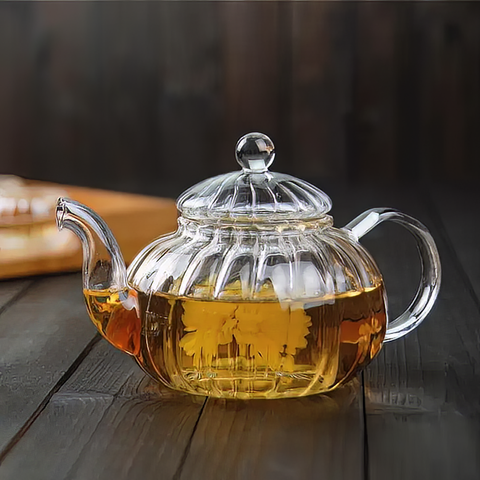Rose Raw Pu-erh Tea Mini Square Bricks
$3.95Rose Raw Pu-erh Tea Mini Square Bricks
$3.95- Gallery
- Description
- About Pu-erh Tea
- Puerh Tea Preparation
- Reviews
Rose Raw Pu-erh Mini Square Bricks are a good choice for people who are new to Pu-erh, wanting the richness of Pu-erh but with a sweeter and mellower taste. The Rose Raw Pu-erh Mini Square Bricks were made of aged loose leaf raw Pu-erh mixed with rose petals. The rose petals add sweetness and lightness to the taste of raw Pu-erh. The clear golden yellow liquor tastes smooth and mellow with a lingering sweet aftertaste. The mini Pu-erh square bricks were measured to approximately 5 grams each, which is the general serving size for a pot of loose leaf tea.
Our Rose Raw Pu-erh Tea Mini Square Bricks is sold by the ounce, which is between 5 and 6 bricks. This is a rough estimate, so we will attempt to err slightly over rather than under whenever possible.
Ingredients: Vintage Sheng Puerh Tea, rose petals
Origin: Menghai, Yunnan Province, China

Pu-erh tea is made from the broad leaf variety (camellia sinensis var. assamica) of the tea plant camellia sinensis from the Southwest region of Yunnan China, believed to be the birthplace of tea. Over 2000 years ago, the people of the area began cultivating "tea gardens," open areas, mostly in the high mountains, where tea trees are grown, coexisting with the native plants and ecology. Today these tea gardens continue to be tended and harvested by the aborigines of this region. Not only are we privileged to be able to consume tea from these ancient tea trees, the traditional packaging and processing of the tea have remained essentially unchanged to this date, earning Pu-erh tea the reputation of being the "King of Teas" or the "Historical Tea."
While most teas, by and large, are best consumed soon after production to retain both their flavor and antioxidant value, Puerh can be aged and refined like wine. It undergoes a fermentation process where microbes act on the tea leaves over time, causing the leaves to darken and the flavor to change, becoming smoother. Depending on the conditions and environment of aging, the taste can transform through various stages of being fruity, nutty, grassy, herbal and earthy.
There are two types of tea we in the West commonly know as Puerh. Raw Puerh (Sheng tea) and Ripe Puerh (Shu tea). The difference is in the aging process. Raw Puerhs are typically fermented very slowly by being stored in cellars and aged for up to 25 years. These teas, typically priced well out of range of the average tea lover, usually reside in the collections of exceptionally wealthy Chinese tea aficionados – their presence on the international markets is incredibly rare. Raw Puerh vintages are characterized by warm tones of earth, damp moss and oak that shift and shape during the aging process.
Both types of Puerh Tea (Raw and Cooked) are made with Sai qing “sun-cured green tea,” which is processed by withering, roasting, rolling, kneading and drying the leaves in the sun.This is how Raw Puerh is made: After it is processed as Sai Qing, the tea leaves can either be left loose or compressed into shapes. At this point the tea may either be consumed in this “raw” green/semi-green form, or properly stored for aging, (which means the tea will be subject to further oxidation and to natural fermentation).This is how Cooked (or “ripened”) Puerh Tea is made: It is subjected to a transformation through natural fermentation. After the tea leaves have been processed as Sai qing, they are intentionally fermented in piles by adding purified water and mixing the tea leaves in a well-ventilated, climate and temperature controlled room. This process is similar to composting.Once the desired fermentation is complete, the tea is sorted, graded, and then processed as either loose pu-erh or it can be compressed into shapes (like tea bricks or tea cakes).
Brewing Instructions
Water Temperature: Boiling
Water Quality: Best with Spring Water
Amount of Leaf (per 6 fl oz water): 5 to 8 grams
Steep Time: 5 to 30 seconds
Number of Infusions: up to 20
There are several schools of thought on how to best prepare Puerh tea. Fortunately, Puerh is very versatile and forgiving. Infused light it is perfect for regular drinking, but it can also be made very strong for small sips after greasy meals. Always blanch the leaves well before infusion with boiling water. Use a genuine Yixing pot for best results.
In contrast to preparing other kinds of tea Puerh does not require a long infusion time. Rather, all Puerh tea is traditionally prepared in the gongfu style using an Yixing teapot or a gaiwan with a high leaf to water ratio and many short infusions. We recommend using between 5 and 8g per serving. The first infusion rinses and "wakes up" the tea and is then discarded. Subsequent infusions are brewed in sort of a "touch and go" style. As soon as the water is poured, the lid is replaced and the tea liquor is immediately poured into a cha hai, or serving pitcher. We recommended accumulating the 1st and 2nd infusions in the pitcher in order to even out the flavor and taste. For each subsequent brewing, no more than 5 to 30 seconds is recommended. By brewing in this fashion you will get as many as 20 infusions.
To break off pieces from the Puerh Tea brick, use a letter opener or similar shaped knife. Insert the knife or letter opener into the brick and gently loosen and lift off a piece. The aim of breaking the brick in this way is to keep as many leaves intact as possible.

































